hankyoreh
Links to other country sites 다른 나라 사이트 링크
Dongducheon to recover small portion of US Army base in return

When the South Korean Ministry of National Defense (MND) announced on Dec. 11 that it would be immediately resuming control of four American bases — namely, Camp Eagle and Camp Long in Wonju, Camp Market in Bupyeong, and the Shea Range at Camp Hovey in Dongducheon — Wonju and Incheon welcomed the move, saying it would facilitate balanced regional development. In contrast, Dongducheon had to swallow its disappointment about only recovering a small parcel of the American facilities there, in the hope that this means the main base will be returned.
“Camp Market was turned into an arsenal by the Japanese colonial authorities in 1939 and was then used by the American troops after Korea’s liberation. 80 years later, it’s finally being returned to the public,” enthused Park Nam-chun, mayor of Incheon, in a press conference on Wednesday. Though the decision to return Camp Market was made in 2002, the actual handover was delayed for 17 years because of a long-running dispute over an environmental survey and follow-up action.

On the same day, the city of Incheon announced its strategy for the future of Camp Market in Bupyeong, which includes setting up an “info center” that will encourage residents to join the debate about how the land should be used.
Camp Long (340,000 square meters), in Wonju, Gangwon Province, will be reborn as a public park. The city intends to build a park after cleaning up pollution in the soil, which will take about a year. Along with building an archery center and a swimming pool that meets international standards, the city will renovate the old barracks into a “book café” and other recreational spaces.
But there still aren’t any specific plans about what to do with Camp Eagle, which formerly housed the US Air Force’s 8th Fighter Wing.
“A decades-old dream has finally come true. The two bases ought to be used as public spaces for citizens, as originally intended. We need to assign the question of Camp Eagle’s future use to Wonju’s private-public-military deliberative body for mutually beneficial cooperation,” said Lee Seon-gyeong, head of an NGO in Wonju.
Meanwhile, there was a muted response from Dongducheon about the handover of Shea Range, which represents just 23,000 square meters of the total 14.05 million that comprise Camp Hovey. While Dongducheon has been hoping to turn the base into a “leisure town” for senior citizens, it doesn’t think that the project can move forward with the parcel currently being returned.
“This tiny scrap of land has no practical value, and we don’t have any plans for developing it. Even so, we hope this is a signal that the rest of the base will be returned,” a Dongducheon official said.
Local residents want bases returned to revive local economiesLocals agree that the remaining American bases in Dongducheon — including Camp Mobile, Camp Hovey, parts of Camp Castle, and Camp Casey — need to be returned in order to revive the local economy, which was ravaged by the movement of American troops away from the city.
“We need to get control of Camp Hovey and Camp Mobile at the same time if we’re going to devise a comprehensive development plan; it’s completely useless to get the firing range all by itself. Given delays in the implementation of previous agreements, we’ll keep an eye on developments and respond accordingly,” said Han Jong-gap, chair of a citizens’ committee charged with responding to the redeployment of American troops away from Dongducheon.
American bases originally covered 42% of Dongducheon’s total municipal area, 43% of which remains to be returned to the city.
By Park Kyung-man, North Gyeonggi correspondent, Oh Yoon-joo, Cheongju correspondent, Lee Jung-ha, Incheon correspondent, and Choi Ye-rin, staff reporter
Please direct comments or questions to [english@hani.co.kr]

Editorial・opinion
![[Editorial] Yoon must halt procurement of SM-3 interceptor missiles [Editorial] Yoon must halt procurement of SM-3 interceptor missiles](https://flexible.img.hani.co.kr/flexible/normal/500/300/imgdb/child/2024/0501/17145495551605_1717145495195344.jpg) [Editorial] Yoon must halt procurement of SM-3 interceptor missiles
[Editorial] Yoon must halt procurement of SM-3 interceptor missiles![[Guest essay] Maybe Korea’s rapid population decline is an opportunity, not a crisis [Guest essay] Maybe Korea’s rapid population decline is an opportunity, not a crisis](https://flexible.img.hani.co.kr/flexible/normal/500/300/imgdb/original/2024/0430/9417144634983596.jpg) [Guest essay] Maybe Korea’s rapid population decline is an opportunity, not a crisis
[Guest essay] Maybe Korea’s rapid population decline is an opportunity, not a crisis- [Column] Can Yoon steer diplomacy with Russia, China back on track?
- [Column] Season 2 of special prosecutor probe may be coming to Korea soon
- [Column] Park Geun-hye déjà vu in Yoon Suk-yeol
- [Editorial] New weight of N. Korea’s nuclear threats makes dialogue all the more urgent
- [Guest essay] The real reason Korea’s new right wants to dub Rhee a founding father
- [Column] ‘Choson’: Is it time we start referring to N. Korea in its own terms?
- [Editorial] Japan’s rewriting of history with Korea has gone too far
- [Column] The president’s questionable capacity for dialogue
Most viewed articles
- 1Months and months of overdue wages are pushing migrant workers in Korea into debt
- 2[Guest essay] Maybe Korea’s rapid population decline is an opportunity, not a crisis
- 3Dermatology, plastic surgery drove record medical tourism to Korea in 2023
- 4Under conservative chief, Korea’s TRC brands teenage wartime massacre victims as traitors
- 5[Column] Can Yoon steer diplomacy with Russia, China back on track?
- 6First meeting between Yoon, Lee in 2 years ends without compromise or agreement
- 7“Korea is so screwed!”: The statistic making foreign scholars’ heads spin
- 8[Editorial] Japan’s rewriting of history with Korea has gone too far
- 9Two factors that’ll decide if Korea’s economy keeps on its upward trend
- 10[Column] For K-pop idols, is all love forbidden love?